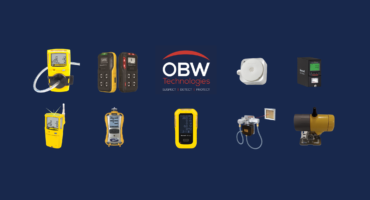Cleaning & Sanitising Your Gas Detection Units
Electrochemical and catalytic bead sensors are used in toxic and combustible gas detectors because they are designed to be very sensitive to specific target gases. Other chemical compounds, such as those contained in some cleaning and antiseptic chemicals, can impact the operation of these sensors. When these materials are used to clean or disinfect gas detectors, they may cause temporary or permanent alterations in the sensor’s sensitivity.
Do
Bump Test and or Calibrate your gas detection unit after cleaning or disinfecting.
Remove antiseptic products from all areas where gas detectors are used and stored.
After sanitising hands allow enough time for the active ingredients to evaporate before handling gas detectors.
Do routine cleaning & disinfecting of gas detection units and use water and hand soap that doesn’t include any of the below cleaning agents. Clean with soft, damp cloth.
Don’t
Sanitise detectors with cleaning agents which include the following active ingredients:
• Alcohol, including products such as Purell® and Lysol® or Lysol wipes
• Sodium hypochlorite (bleach), including products such as Clorox® or Clorox wipes
• D-limonene, including products such as Dawn® or Sunlight® dishwashing liquid
Not clean or disinfect gas detectors, if you follow the above conditions and bump test after cleaning you will minimise any risk of failure.
If you have questions about the care and maintenance of your gas detectors, please contact our service engineers.
Bump Testing Gas Detection Units
A portable gas detector may be full charged and look fully functional from the outside but how do we know the internal sensors and alarms all work? A bump test is used to ensure that a gas monitor is operating at its best by exposing it to a known concentration of the target gas for a short period of time.
Do
Bump Test each unit prior to each use.
Allow 30 – 40 seconds to alarm.
The reading is compared to the real amount of gas present, as specified on the test gas cylinder, and if the detector alarms within an acceptable range of the actual concentration, usually within 10%, it is safe to use.
Verify the dock station is communicating with the detector – no IR communication failures – if so RMA is required.
The dock is unable to detect the proper readings and alarms, check inlet settings and concentrations in the MD-II menu.
Calibrate if the monitor is not alarming properly or any factor of the bump test fails.
Don’t
Don’t use Gas Detector without bump testing.
Don’t use until a full calibration has been performed if the bump test results are not within the permissible range or it takes more than 30- 40 seconds to alarm.
Don’t use expired or empty gas cylinders. Results won’t be accurate and alarms mightn’t go off.
The gas is not being applied to the instrument properly, typically caused by incorrect tube type – should be Teflon tubing and NOT medical grade tubing.
Frequency & Importance of Calibrations
There’s a lot of confusion surrounding when an instrument needs to be calibrated. Some think once a year, others quarterly – so how often should you be calibrating your gas detector?
Do
Typical calibration frequencies for most applications are between 3 and 6 months.
The recommended calibration period for gas detectors is six months although the frequency may need to be increased where continual exposure to the target gases or contaminants is experienced.
Between the calibrations it is also recommended that the response of the detector is checked using an appropriate test gas cylinder i.e. bump testing as mentioned above.
Establishes sensor(s) baseline reading, 20.9% oxygen, and free of any toxic or combustible gas vapours. To maintain a stable baseline, it is essential to perform zero in the fresh air.
Perform a zero to re-establish baseline as required, and before a span calibration. This is the adjustment of the sensor(s) response to match the value of a known concentration of applied gas.
The calibration procedure should be done in accordance with the equipment manufacturer’s instructions.
Don’t
Don’t miss or push out a calibration longer than 6 months as we nor the manufacturer can guarantee reliability with the sensors after the 6-month period.
Only allow your devices to be calibrated and serviced by a gas detection specialist as we see devices being calibrated/serviced incorrectly on a regular basis. They may look like they are working but a sensor may be incorrect or installed wrong.
Don’t fail a bump test and continue to use, calibration must be completed.
Don’t continue to use without bump test or calibration when used multiple times or mishandled/damaged.
Don’t try to calibrate yourself, contact a member of our specialist service team.
Additional Info
Do
You may need to get an O2 sensor prematurely changed out to avoid leaking.
Turn on the detector in fresh air to avoid false-negative readings.
If you see a persistent Non-Compliance Symbol on a BW Clip4 for example or any other device please contact our service department.
Ensure sales team knows your required configuration and gas risks to best help fulfil your needs and send you a properly configured gas detector with the correct sensors.
If you get a NEG/-0 alarm it usually means that the instrument’s sensor is reading a number below zero. This can occur in a situation where the PID sensor may have been contaminated, therefore it is recommended to clean the PID detector with a methanol bath.
Don’t
Don’t take gas detector apart, use correct maintenance procedures and verified service agents.
Don’t remove memory cards as data will be lost and won’t be tracked.
Don’t attempt to remove any sensors and only use authorised sensors.
From the Blog



If you have any questions about our products or services, please feel free to contact us.
From the Blog



If you have any questions about our products or services, please feel free to contact us.

Join our mailing list to receive the latest news and updates from our team.